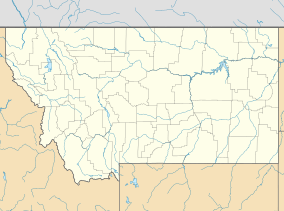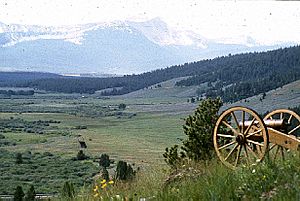Big Hole National Battlefield facts for kids
Quick facts for kids Big Hole National Battlefield |
|
|---|---|
| Location | Beaverhead County, Montana, USA |
| Nearest city | Dillon, MT |
| Area | 1,010 acres (4.1 km2) |
| Established | 1883 |
| Visitors | 36,290 (in 2011) |
| Governing body | National Park Service |
| Website | Big Hole National Battlefield |
Big Hole National Battlefield is a special place in Montana, USA. It protects the site of a big battle from the Nez Perce War. This war happened in 1877. Here, the Nez Perce people fought against the U.S. Army. They were trying to reach Canada for safety.
The Battle of the Big Hole was the biggest fight in this five-month war. It happened on August 9 and 10, 1877. In 1992, this battlefield became part of the Nez Perce National Historical Park. This larger park includes 38 different locations across five states. These places show the path the Nez Perce tribe took during their flight from the U.S. Cavalry.
Big Hole National Battlefield covers about 1,010 acres. It is located about 10 miles west of Wisdom, Montana. You can find it on Montana state highway 43. There is a visitor center at the park that is open all year.
Contents
History of the Nez Perce War
The Nez Perce people originally lived in lands that are now Oregon, Washington, and Idaho. In 1873, their leader, Chief Joseph, tried to make sure his people could stay on their land. This land was in the Wallowa Valley. Earlier agreements from 1855 and 1863 had promised this land to them.
However, many miners broke these agreements by moving onto Nez Perce land. The U.S. government did not stop them. In 1877, President Grant signed an order to give the Wallowa Valley to the Nez Perce. But he changed his mind two years later. More white settlers then moved onto the land. Some Nez Perce people were killed.
Because of these problems, Chief Joseph decided it was best to leave. He was a peaceful leader. He feared the U.S. Army would force his people onto reservations. He hoped to escape to Canada. He believed they would be treated better there. He also hoped to join Sitting Bull, a leader of the Lakota people, who was already in Canada.
The Battle of the Big Hole
The Nez Perce began their journey to Canada. Along the way, they faced U.S. Army forces. At White Bird Canyon, Major General Howard's troops attacked the Nez Perce. The Nez Perce had come to talk under a white flag, but they were fired upon. The Nez Perce won this first fight. They killed 34 soldiers, while only two of their warriors died.
About 750 Nez Perce people were now traveling towards Canada. Only about 200 of them were warriors. Six weeks after leaving their homeland, the U.S. Army attacked them again. This time, it was a surprise attack before dawn. It happened at Big Hole.
The Nez Perce fought back bravely. They managed to push the attacking soldiers onto a hillside. While the fighting continued, the Nez Perce women and children fled the area. They first buried their dead. During this battle, the Nez Perce lost an estimated 60 to 90 people. Many of those killed were women and children. The U.S. forces lost 28 soldiers. Another 40 were seriously hurt. This was the most violent battle between the Nez Perce and the U.S. government.
After the Battle
After the battle, the Nez Perce continued their journey east. They traveled through Yellowstone National Park. Then they headed north. In October 1877, they were only about 40 miles from the Canada–US border. They were in Montana's Bears Paw Mountains. By this time, they were starving and very tired.
The Nez Perce surrendered to U.S. forces. General Oliver O. Howard and General Nelson A. Miles had promised they could return to their home in the Wallowa Valley. But this promise was not kept. About 150 Nez Perce warriors escaped to Canada before the surrender. About 450 women, children, and elderly people were left.
When Chief Joseph finally surrendered, he gave a famous speech. He said, "Hear me, my chiefs! I am tired. My heart is sick and sad. From where the sun now stands I will fight no more forever." The Nez Perce were sent to the Colville Reservation in Washington state. Chief Joseph was never allowed to return to his beloved Wallowa Valley until 1900. Even then, he was only allowed to visit his father's grave. The Nez Perce were known as tall, handsome people. They farmed their land before settlers arrived.
About the Battlefield Site
The Big Hole site became a Military Preserve in 1883. It was named a National Monument on June 23, 1910. Later, on May 17, 1963, it was renamed a National Battlefield.
In 1977, the walking trails at the site were named a National Recreation Trail. The battlefield is also listed on the National Register of Historic Places. This happened on October 15, 1966. It is managed by the National Park Service.
- The National Parks: Index 2001–2003. Washington: U.S. Department of the Interior.




